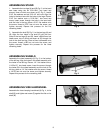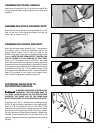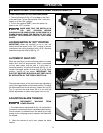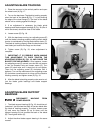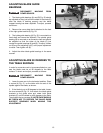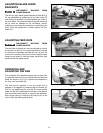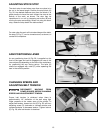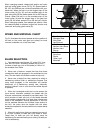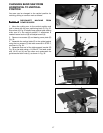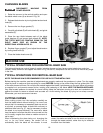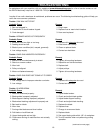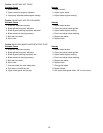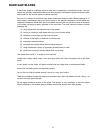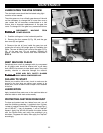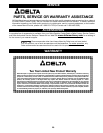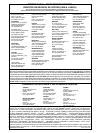
18
TYPICAL OPERATIONS FOR VERTICAL BAND SAW
NOTE: THIS BAND SAW IS RECOMMENDED FOR USE IN CUTTING METAL ONLY.
Before starting the machine, see that all adjustments are properly made and the guards are in place. Turn the upper
wheel by hand to make sure that everything is correct BEFORE turning on the power. Keep the top guide within 1/8"
of the work piece at all times. Do not force the material against the blade. Light pressure on the work piece will produce
a smoother cut, and prevent excess friction, heating, and hardening of the blade. KEEP THE SAW BLADE SHARP.
Very little forward pressure is required for normal cutting. Keep the workpiece moving at a slow and consistent rate
against the blade to ensure a smooth and accurate cut. Avoid twisting the blade by trying to turn sharp corners.
Remember, you must saw around corners.
Fig. 37
CUTTING CURVES
When cutting curves, turn the workpiece carefully so
that the blade follows without twisting. If a curve is so
abrupt that it is necessary to repeatedly back up and cut
a new kerf, a narrower blade, a blade with more set, or
additional relief cuts Fig. 37, may be necessary to allow
the blade to cut more efficiently. The more set a blade
has, the easier it will allow the stock to be turned, but the
cut is usually rougher than where a medium amount of
set is used.
When withdrawing the piece being cut, changing the
cut, or for any other reason, be careful not to
accidentally draw the blade off the wheels. In most
CHANGING BLADES
DISCONNECT MACHINE FROM
POWER SOURCE.
1. Raise the saw arm to the vertical position and open
the blade wheel cover (A) as shown in Fig. 36.
2. Release blade tension by turning blade tension hand
knob (B).
3. Remove the two finger guards (C).
4. Carefully slip blade (D) off both wheels (E), and guide
assemblies (F).
5. Place the new blade between each of the blade
guide bearings (F) and around both wheels (E). NOTE:
THE TEETH MUST BE POINTING DOWN ON THE
RIGHT HAND SIDE AS SHOWN BY THE
DIRECTIONAL ARROW IN FIG. 31.
6. Replace finger guards (C), and adjust blade tension
by turning hand knob (B).
7. Close the blade wheel cover (A).
Fig. 36
B
E
C
F
A
F
C
D
E
TEETH
DIRECTION
MACHINE USE
TYPICAL OPERATIONS FOR HORIZONTAL BAND SAW
The horizontal band saw cuts all types of metals, including ferrous and non-ferrous metal, steel pipe, angle iron,
conduit, brass, aluminum and copper. As shown in Fig. 24 and 25, workpieces can be cut at 90 or tilted to any angle
in the vise.
cases, it is easier and safer to turn the stock and saw out
through the waste material, rather than try to withdraw
the stock from the blade.



